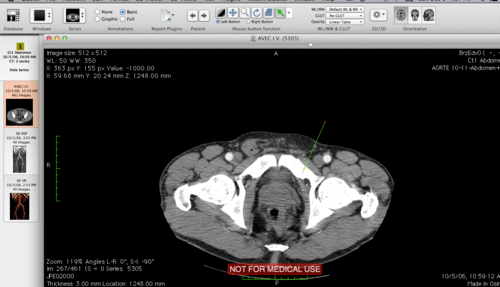Making Medical Images Tangible and Shareable
- Celeste

- Aug 3, 2019
- 2 min read
Updated: Jun 7, 2023
If you break a bone or get sick your doctor might have you get an X-ray, CT, or MRI scan. These tests help doctors get a better look at what's going on inside your body.
The grayscale images created by these tests can look like abstract art to people who don't spend a lot of time looking at medical images.
But there's a way to turn these abstract images into a variety of educational tools using digital fabrication and visualization techniques.
Note: these instructions are from 2019, software and technologies change! There may be a different or better way to go through this process now.
Here's how I turned a CT scan into a 3D model of a hip bone (the os coxa if we're being anatomically accurate)
I found a CT scan available for educational use and opened the scan in Osirix, a free medical image viewer program with built in CT scan to 3D model features. (see first picture below)
I used Osirix's tools and my anatomy knowledge to isolate the bones on one side of the hip and downloaded that selection as a 3D file. (see white model in second picture below)
I used a few different 3D modeling programs (Meshlab, Zbrush, Meshmixer) to isolate the bone that I wanted to print and to "clean up" the model. (see grey model in second picture below). Each of the 3D programs I used had different features that I found useful, there are many different programs that you could use instead of these. Blender is a popular free and open source option.
Here are two different ways that you could use this 3D model:
1. 3D print: Now that the model has been cleaned up in my 3D modeling programs it can be 3D printed at life size. (see image below) Not only is that pretty cool, but it gives learners a new way to interact with real medical data. Learners can touch and hold what started out as a series of black and white images. A 3D printing file also has the advantage of being more cost-effective than a manufactured medical model or a real anatomical specimen. You can 3D print this file on any 3D printer for a couple dollar's worth of plastic. If a student breaks the model you can print it again. That's not to say that medical models and anatomical specimens aren't valuable. I'm a strong believer in the benefits of both and there are definitely times where real anatomy and anatomy modeled by experts are better than a 3D print. The 3D print pictured below was printed on a Stratasys printer, but this hip bone model can be printed on any 3D printer. Including 3D printers that you might be able to find at your local library or makerspace.

2. View online: You can upload this model to Sketchfab. Sketchfab lets other people interact with your 3D model online for free. You can label your model to pump up the educational impact and there are even some virtual reality features that you can experiment with.






